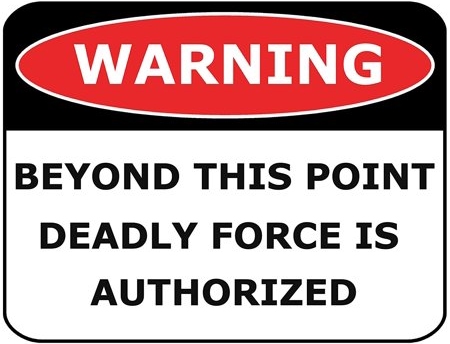
[An attorney consulted me about his “self-defense” case. His client had wielded a large, heavy shovel, shattering his “assailant’s” radius and ulna. Permanent disfigurement (surgical scars) and minimal function loss resulted. The defense was to be “I used lawful non-deadly force against unlawful non-deadly force.” . . . . . . Good luck with that I told him.]
State-specific definitions and peculiarities aside (including, if any, role of actor’s intent), ask someone what is deadly force, and you will likely hear the correct answer: force that is likely to cause death. As an afterthought or, upon prompting, the person may add (correctly): or great/grave/serious bodily injury/harm. I write here about that aspect of deadly force. Great/grave/serious bodily harm or injury is often loosely described as that which is significant or substantial physical injury; an injury that will likely be greater than minor or moderate harm. For “likely,” think probably, something having a chance of happening greater than 50-50.
State statute and case law may define deadly force only with a bare-bones sentence, and define great/grave/serious bodily harm generally or specifically. Let’s look at some examples (taken from a cursory review of statutes, appellate court cases, or court-approved jury instructions):
- Arizona – “Deadly physical force” means force that is used with the purpose of causing death or serious physical injury or in the manner of its use or intended use is capable of creating a substantial risk of causing death or serious physical injury.
- New York – “Deadly physical force” – physical force which, under the circumstances in which it is used, is readily capable of causing death or other serious physical injury. Serious physical injury means impairment of a person’s physical condition which creates a substantial risk of death, or which causes death or serious and protracted disfigurement, protracted impairment of health or protracted loss or impairment of the function of any bodily organ.
- Minnesota – Great bodily harm means bodily injury which creates a high probability of death, or which causes serious permanent disfigurement, or which causes a permanent or protracted loss or impairment of the function of any bodily member or organ or other serious bodily harm.
- Washington – Great personal injury means an injury that the slayer reasonably believed, in light of all the facts and circumstances known at the time, would produce severe pain and suffering if it were inflicted upon either the slayer or another person.
- New Mexico – Great bodily harm means an injury to a person which creates a high probability of death or results in serious disfigurement] or results in loss of any member or organ of the body or results in permanent or prolonged impairment of the use of any member or organ of the body.
- Massachusetts – Acts intended to cause serious bodily injury constitute the use of deadly force in the context of self-defense. Serious bodily injury is defined as one that results in a permanent disfigurement, a loss of bodily function, the loss of a limb or bodily organ or a substantial risk of death.
- Florida – Great bodily harm does not include injuries which are slight, minor, moderate or trivial, or bruises such as those which might be suffered in a simple battery.
- Pennsylvania/Texas – Serious bodily injury is bodily injury which creates a substantial risk of death or which causes serious, permanent disfigurement, or protracted loss or impairment of the function of any bodily member or organ.
Some specific injury examples discussed in cases and legal articles:
- Not deadly force: OC (pepper) spray or “stun” gun temporary disabling effect; face slap injury; one-hand push causing mild fall
- Deadly force: Punch to eye socket; broken bone; serious or large burn; continued choking; bumping with vehicle; trained kick to male groin
Takeaway: What constitutes deadly force is as weighty a legal question as when is the use of deadly force lawful. The definition of deadly force in your state likely includes numerous types of weapons and related injuries other than firearms and sharps (knife, razor, etc.). More to know to help you get the paradigm MAY correct. While you are at it (learning law from an actually trained and licensed attorney), see how your state law defines “deadly weapon.” And who makes the deadly and non-deadly determinations, judge (legal question) or jury (fact question).
Disclaimer: No MSW post constitutes particularized legal advice, or creates an attorney-client relationship with a reader.


